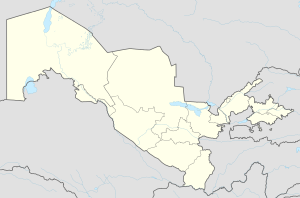Asaka, Uzbekistan
|
Asaka Asaka/Асака |
|
|---|---|
| City | |
| Location in Uzbekistan | |
| Coordinates: 40°38′N 72°14′E / 40.633°N 72.233°E | |
| Country |
|
| Region | Andijan Region |
| District | Asaka District |
| City status | 1937 |
| Elevation | 495 m (1,624 ft) |
| Population (2010) | |
| • Total | 66,000 |
| Time zone | UZT (UTC+5) |
| • Summer (DST) | not observed (UTC+5) |
| Postal code | 170200 |
| Area code(s) | +998 74 |
Asaka (Uzbek: Asaka/Aсака; Russian: Aсака) is a city and the administrative center of Asaka District in eastern Uzbekistan, located in the southeastern edge of the Fergana Valley near Uzbekistan's border with Kyrgyzstan.
Asaka underwent rapid industrialization during the Soviet era. Currently, it is the second biggest industrial city in Andijan Region, the first being Andijan. Asaka is home to the first automobile assembly plant in Central Asia, namely GM Uzbekistan (formerly UzDaewooAuto).
The origins of the city's name are uncertain. Some sources say that it derives from the Saka words "asvaka" or "as-saka" which mean "horse" or "horsemen", respectively. That is why a statue of a horse was erected in one of Asaka's squares in 1997 during the 60th anniversary of the city's founding. According to others, "Assake" (the original name of the city) is an ancient term derived from the Iranian ethnonym referring to Central Asian Scythians.
It has been known since ancient times as Assake. The early history of Assake has not been studied extensively. Avaz Muhammad Attor, a 19th-century historian, mentioned Assake in his book Tarixi jahonnoma (World History). According to him, Khudayar Khan had built a castle in the territory of present-day Asaka. Assake started to grow fast after the nearby city of Andijan and Tashkent were connected with a railway line. At the turn of the 20th century, Assake had a population of only 2,000 people.
In 1924, Assake was renamed Zelensk, after a local official. In 1937, it was granted town status and again renamed, this time Leninsk, after Vladimir Lenin. The city underwent rapid industrialization during the Soviet era. In 1946, a large electric motor plant was built in Asaka. In the 1960s, the city specialized in processing agricultural goods.
...
Wikipedia

